In exactly two weeks, I’m heading to Salt Lake City for Sewing Summit, and get to meet a bunch of folks I only know from online and hang out with friends who I only get to see once or twice a year. And stay up late hand sewing, and listen to other geeky sewing types talk about ridiculously obscure sewing topics and look around, realizing that not a single person in the room is bored. And try my hand at some new techniques, and eat some yummy food and talk pretty close to non-stop about how important I think pockets are on nearly everything you sew. Forty-eight hours of geeking out over needle and thread. Yeah, baby.
Today, I’m checking in with Travel Handmade and offering up a little sewing project to make all our travels easier–particularly those of us headed to Salt Lake in October. I love all the bags and totes and projects other folks have created for this series, but wanted to play to my strengths; plus, when I think about travel–by myself, without children–I think less about bags and luggage and more about my own comfort. Having flown as far as Hawaii with a small child (you can see my zipper pouch that I made for toting all her necessaries), and being someone who sincerely loves to fly, I look forward to trips alone as a true luxury, and want to enjoy every aspect of the trip.
I always, always get cold on flights, but I am a staunch supporter of dressing like a human when traveling–no sweat pants and fleeces for me. I think part of fun is the getting there, not just the destination–my grandfather taught me that, and so far, the man has never been wrong. But I also don’t want to feel trussed up like a turkey, to the point that I can’t get comfortable while in my itty-bitty seat. Solution: a super simple elastic-waist skirt that doesn’t look like an elastic waist skirt, so I can have the best of both worlds!
I figured as long as I was at it, I’d put together a quickie pattern that you can print out and make your own. This isn’t super fancy, just a scan of the pattern I drafted for this project that has been graded to offer a range of sizes, but it should make the sewing that much easier for you! Download a copy and assemble the pages, then hit your machine and whip one of these up. You’ll feel better when flying if you can let a little gut relax, but still feel pretty while you’re doing it.
Many elastic waist skirt patterns allow for a LOT of fabric–like, a LOT of fabric. Whole panels of 45″ width fabric. Which, when you gather it up around a 32″ low-waist, is a ton of extra yardage that just makes for lumps and bumps and an unflattering silhouette. This pattern is designed to have a lot less ease in it, which means far less fabric. While it does have an elastic waist, there isn’t nearly as much bulk as you might have seen. So don’t fear the elastic waist! If the sizing is done right, it doesn’t always have to equate with frumpy.
For this sample, I used a mid-weight wool tweed, at least in part because I have a Downton obsession (although I will defensively point out that I have always, my whole life, had a deep and abiding affection for all tweed). This aqua color, found at Fabric.com, is really lovely and has some great greenish slubs in it, so I’ve paired it with a tee and cardigan, always my traveling ensemble of choice. That way, for the 20 minutes you’re trapped on board with no air while they get everyone loaded and taxi to the runway, you won’t swelter, and then once you’re in the air and it’s suddenly far below zero up in the air, you can slip on your sweater and be toasty! I’m all about the comfort while I read my airport newsstand magazines and eat my peanut mega-bag of M&Ms. And then when they do the drink service, I order the Biscoff cookies and a hot tea, and it’s awesome.
I had originally envisioned this pattern as using a bias tape waistband, but when I started cutting into this wool, I knew I wanted to line the skirt. So the instructions below are for a fully lined skirt–which works great for quilting cottons, to give them some weight, and for thicker fabrics that need a barrier between your skin and the fabric. The elastic insertion is super easy here (it’s the same basic concept as the elastic in the Overmost, so if you’ve done that pattern, this will be super familiar to you). I used two channels of elastic here, but mostly because the skinny stuff was what I had on hand; you can certainly use a wider elastic as you make your casing.
The pockets aren’t included in this tutorial–I’m saving those for my class at Sewing Summit! But keep your eyes peeled if you won’t be joining us in Salt Lake–I’ve got an angle on another source for this and a bunch of other pockets that you can ALL play with, once I get home.
Begin by printing the pattern and choosing a size. Because this skirt has an elastic waist, you don’t have to get it exactly right–there’s some wiggle room. Finished garment measurements (estimated) are on the pattern piece to help guide you, but remember that you can move up a size or two if you want to have a little more ease in your skirt. I made the small here, and meant for it to fit like a NOT-elastic waist skirt would fit; if I was using a bulkier fabric or if I just wanted more skirt to my skirt, I could move up to the medium or even the large.
Step 1: CUTTING
There is only one piece here, which serves as both the front and the back of the skirt. Cut on the fold twice, so you have two pieces. I used my serger to finish off the two side seam edges of each piece before stitching them together, because this tweed really wanted to come unraveled. If you’re working with a quilt-weight cotton, you might just zigzag (overcast) over the edges, instead, or you could always sew the side seam and serge after you’re done. For the lining, repeat these steps with your lining fabric.
Step 2: SIDE SEAMS
For the side seams, place your front and back right sides together and sew a 1/2″ seam along both right and left. Press your seam allowances open. Repeat with your lining fabric.
Step 3: ADD LINING
Place the lining and the outer skirt shell right sides together, matching up your side seams. Get them right on top of one another to ensure that the whole skirt lines up properly. Then, pin around the upper edge of the skirt, then sew a 1/2″ seam allowance around the entire upper edge, leaving no opening.
Once the upper seam is sewn, flip the whole skirt so that the lining is inside the skirt and the upper edge seam is exposed:
If you notice that the pockets are already one here, you’re right: I think it’s way, way easier to add the pockets before you do any other skirt assembly, so if you decide to add some pockets to your skirt, you’ll have a smoother installation if you do it very first. Having said that, a simple patch pocket like this can ALWAYS be added on later–so if you’re coming to Sewing Summit and want to make this skirt now to bring with you and add pockets later, you can totally do that!
Step 4: ELASTIC CASING
At the iron, press along that upper edge seam to make a smooth, crisp transition at the waistline edge between the fabric and the lining. THIS is the edge that will be seen along the top edge of your skirt, so make it pretty! With this edge, we’ll begin to form the casing.
From the right side of the skirt, begin sewing in the casing. Measure down the width of your elastic PLUS 1/4″ and sew a seam. Backstitch at the beginning of the seam, leaving a 2-3″ opening when you get back around to where you began. I added a second seam in the middle here because I used two rows of 3/8″ elastic, but if I’d had 1/2″ or 3/4″ elastic, I would have put in a 3/4″ or 1″ seam allowance for my casing and just used one row of elastic for the waist.
Step 5: THREADING ELASTIC
Cut a piece of elastic to fit your waist at the point where you want the upper edge of the skirt to ride–if that’s below the belly button, so be it, but make sure you have enough elastic to go around PLUS one inch. To get the fit right, I tug the elastic slightly so that it’s as snug as I want the waistband to be as I’m wearing the skirt–if it’s too loose, the skirt won’t stay up and you won’t wear the skirt and all this sewing will be wasted.
Reach up between the two layers of the skirt to find the opening you left in your casing seam. You’ve made the casing by sewing through both the skirt and the lining, and now you can thread a piece of elastic into that casing. I use a safety pin to guide the elastic all the way around to the other side. As you’re working, you’ll gather up the bulk of the fabric and pull the elastic through:
This is similar to the way the elastic goes through on the 20 Minute Skirt, so there are more photos there to guide you. When you’re done, you should have a gathered edge along the elastic waistband, usually without too much extra bulk.
Step 6: HEMMING
You might notice that I didn’t actually hem this sample skirt yet:
I was super worried that it was getting late and I’d lose the light to shoot photos of this skirt, but I knew with this lovely wool that I really didn’t want to put in a machine hem. Some fabrics just really ASK you to do a hand-sewn hem, and this is one of them. So I’m planning to hand-sew this bad boy. For you, though, particularly if you’re using a quilt-weight cotton–where I think a machine-sewn hem is completely appropriate–you can add a double-turned hem at this point. Press under 1/4″ along the lower edge of the skirt, then another 1/2″-3/4″ and press again. Then sew! Super easy. More photos over at the 20-Minute Skirt Tutorial, if you need them.
Happy travels, everyone, and hoping to see lots of you in Salt Lake City! You can tell me when you get there what you think of elastic waist skirts–yay or nay? How does this waistband treatment float your boat compared to pressing the upper edge into a casing, the way some patterns do? Can’t wait to talk nerdy sewing with you!



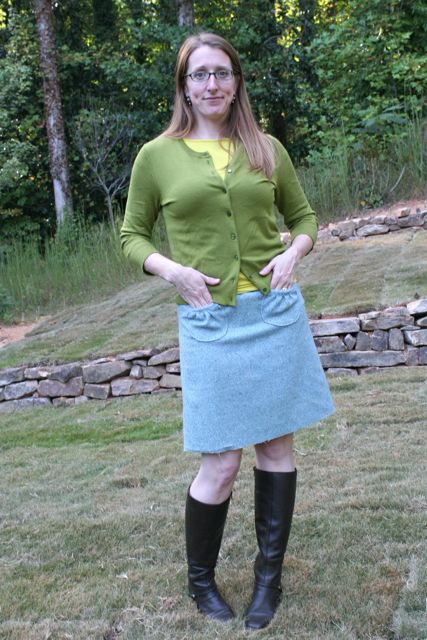
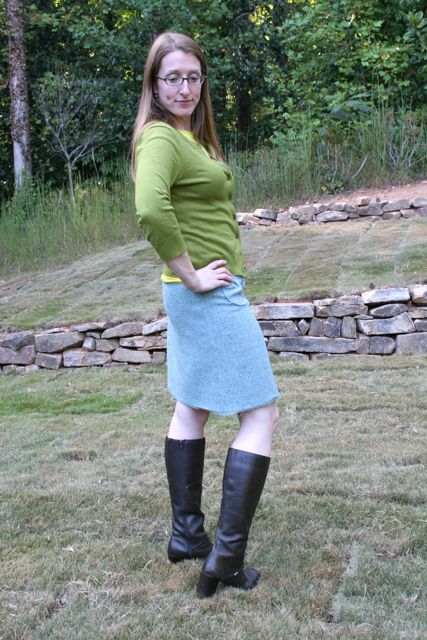
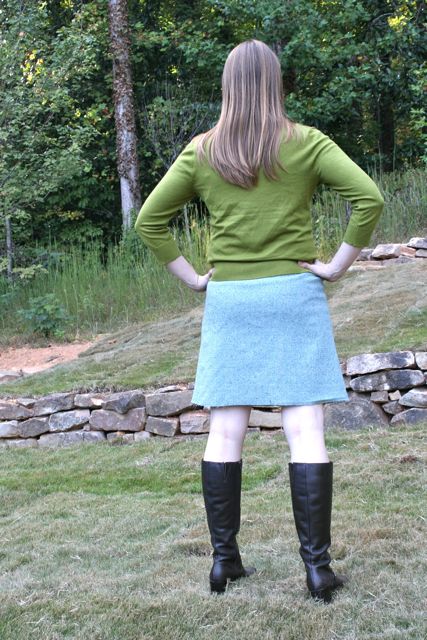
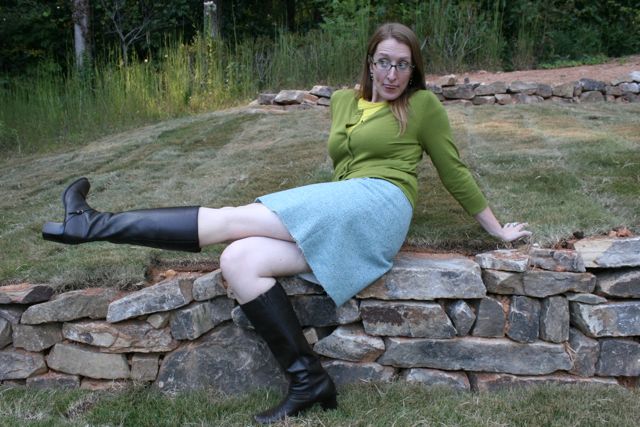
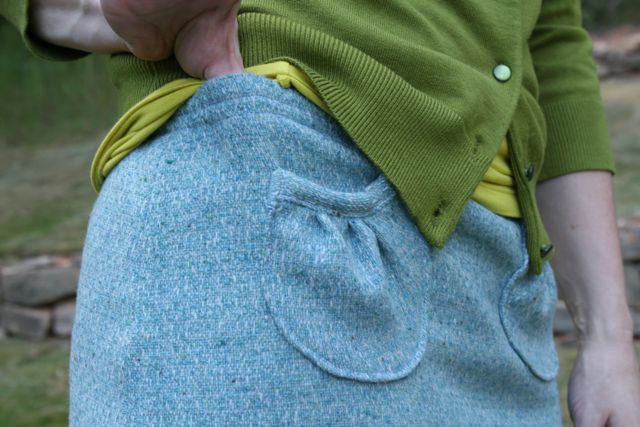
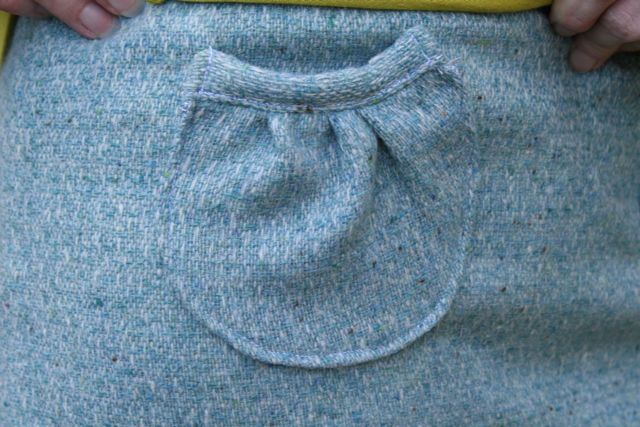

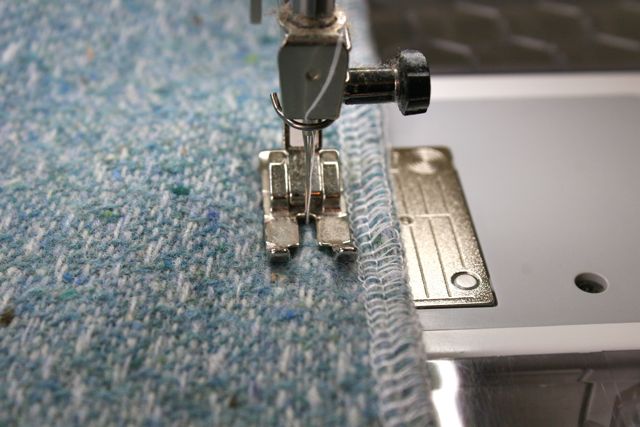
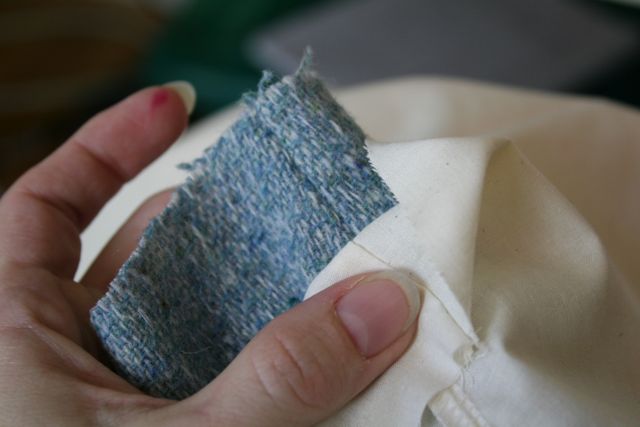
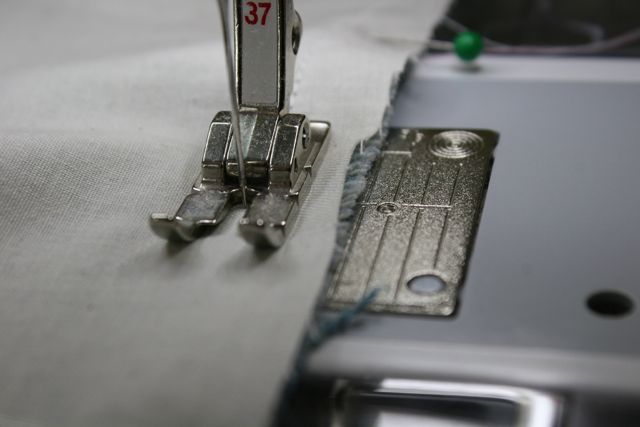
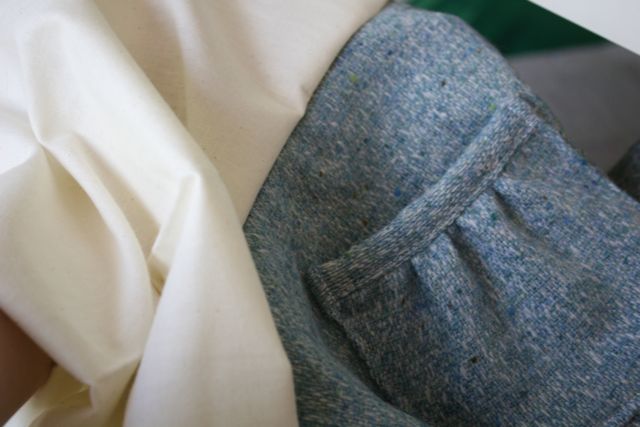
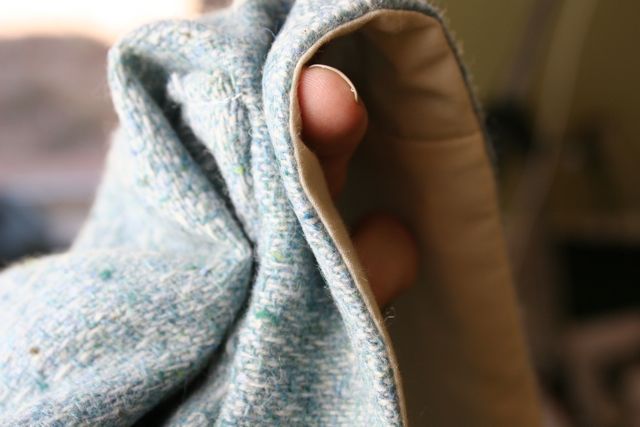

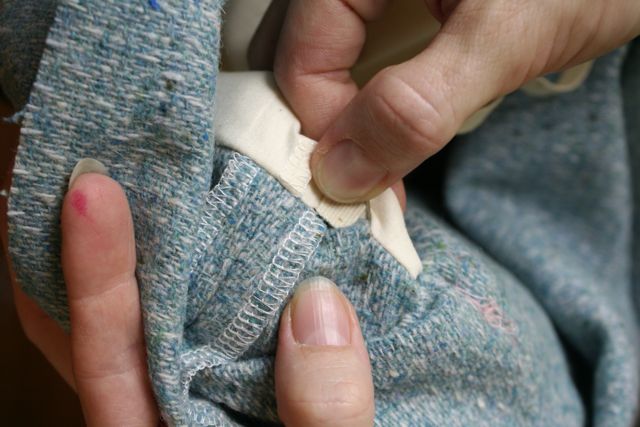
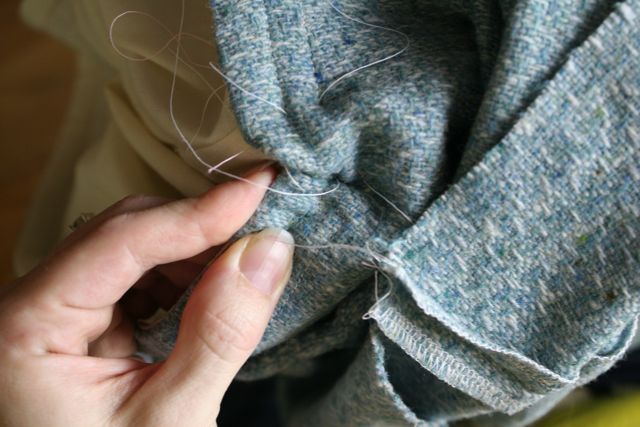
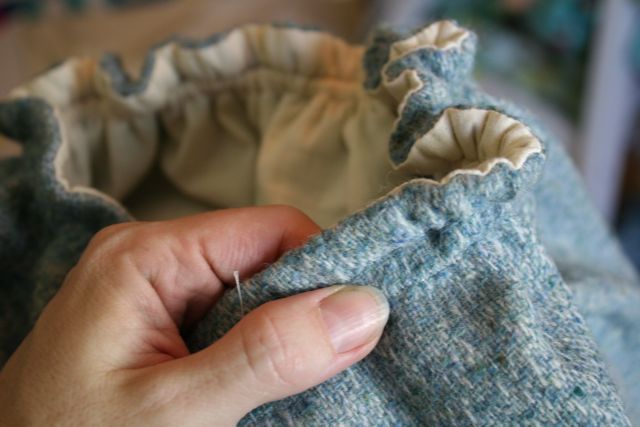
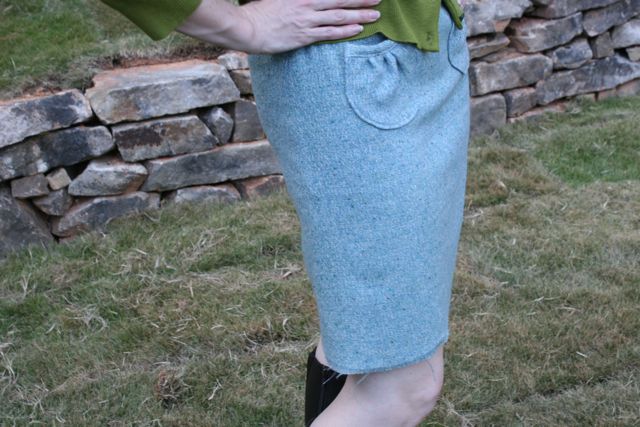
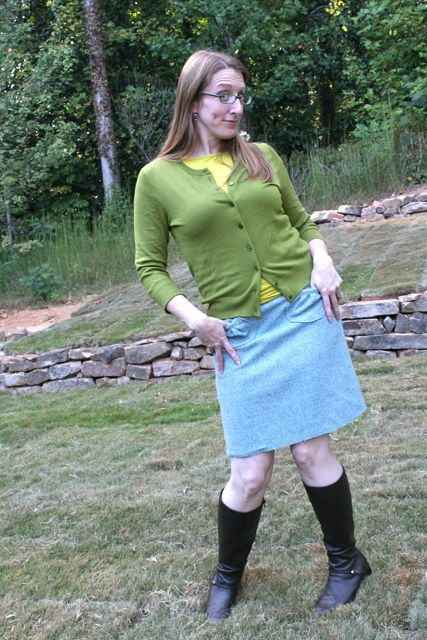
Kim
September 27, 2012 at 1:06 pmSO making this!
Deborah
October 2, 2012 at 12:38 pmOooh, you can wear it to class next time! Or–and call me crazy–you could make it from PATCHWORK. Worlds? Colliding.
Elaine Papworth
September 28, 2012 at 11:54 amI will also be making this darling skirt. Will there be at least 3 of us wearing these skirts at Sewing Summit?
Deborah
October 2, 2012 at 12:38 pmHee!! How fun would that be? 🙂
Rachel at Stitched in Color
September 28, 2012 at 12:51 pmDeborah, you are always the cutest model. The elastic looks real good here. Less ease make sense.
Deborah
October 2, 2012 at 12:37 pmIt’s comfortable, but so many of the elastic-waist skirts I’ve made over the years made me feel lumpy in the midsection. As an non-pear, I don’t have enough other curves to balance it out! So I love the slightly more fitted shape on this one with the reduced ease. Glad you like! 🙂
Emily
October 2, 2012 at 12:34 pmLooks cute & perfect for fall! How much fabric do you need for this? Is a yard enough?
Deborah
October 2, 2012 at 12:36 pmAh! Brilliant question. This wool was 55″ wide, and I folded the two selvedges in toward the center to make two folds–which meant I only needed 3/4 yd. For a 45″ fabric, you’d need 1.25 yds, give or take–I don’t think you’d be able to fit the angle of the side seam on a single yard. Hope that helps!
Michelle
October 7, 2012 at 1:41 amThank you! I am going to try this! I love this idea for doing a lining/casing combo! I didn’t get into your pocket class at SS, but I’ll eagerly await any postmortem on your blog!
Deborah
October 8, 2012 at 9:16 amOh, I’m so glad you like it! I’ll have lots of info and photos of the pockets class for the blog after Sewing Summit, hopefully, so you can get all caught up then. Can’t wait to see your skirt! 🙂
Kristi
October 27, 2012 at 12:47 amThank you for this! I just spent way too much time and effort with a petticoat skirt that turned out awful. I needed something to restore my faith in sewing and this was it! It was super quick. Like a couple hours (which is super fast for me!)
The small fit me perfect and was slimming but I can only get it on over my head because there is not enough give in the waistband to get it over my hips. Is that right? Just want to make sure I didn’t mess anything up there. I figured that might be the “cost” of a skirt with little ease and an elastic waistband. I don’t really care about getting it on that way… Just curious if that was your experience.
genevieve
April 30, 2013 at 5:40 pmi am really excited about making this skirt (i kind of live in elastic waist skirts because they are so comfy)! i just bought a pair of curtains (they feel similar to taffeta but a lighter weight) at a rummage sale for $2 and i was wondering if you thought that type of fabric (along with some lining) would work for this pattern.
thaks!
Nicole
August 17, 2014 at 5:34 pmHi Deborah, Would you consider adding “extra small” to the pattern?
Nicole
August 17, 2014 at 5:38 pmI thought the small would fit me, but it would float, according to the measurements, so I can’t make it. wanted to send you this feedback.
Deborah
August 18, 2014 at 3:25 pmThanks for the feedback, Nicole! I don’t know if I’ll get to it in the next few weeks, but I would love to update this pattern and add smaller sizing. I have a set of women’s patterns coming out in the next month that WILL go down to XXS, though, so hopefully that’s a start! 🙂